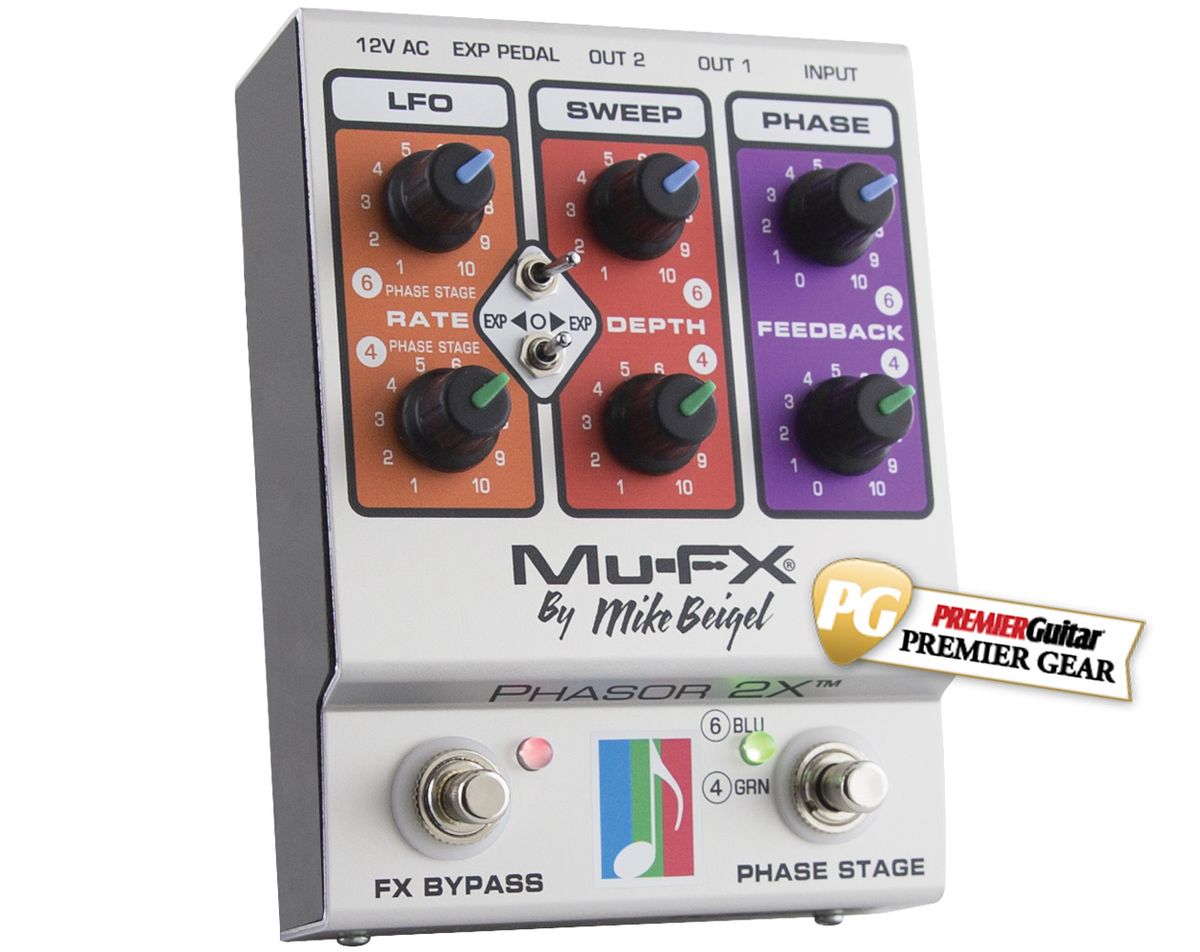
A classic ’70s phaser is resurrected—again!
There have been plenty of phasers over the decades, but only one Phasor. Until now, anyway.
The original Musitronics Phasor was created by stompbox visionary Mike Beigel in 1974. It was a simplified version of Beigel’s earlier Bi-Phase—a dual-oscillator device beloved by many players and producers. Phasor had only simple depth and rate controls, while the later Phasor II added a feedback control. (Phasor II’s existence means my “only one Phasor” sentence was a lie, but hey, why should facts get in the way of a snappy intro?)
Now, 43 years after Phasor’s debut, we have Phasor 2X from Mu-FX, the new brand launched by Beigel himself in 2014. Vintage Musitronics designs are the company’s focus, although the new versions feature savvy refinements and expansions. Phasor 2X is a great example: It’s basically two Phasor IIs in a single enclosure, with the option of real-time control. (Expression pedal not included.) Meanwhile, it adds such cool features as stereo output, 6-stage and 4-stage phasing, and multiple controller modes.
Mini Mu
Phasor 2X resides in Mu-FX’s “mini mu” housing, which reprises the bold colors and bi-level, folded-metal enclosures of old Musitronics designs, but with a modest 5.75" x 4.25" footprint. It’s smaller than an original Phasor, and way smaller than the unwieldy Bi-Phase. It’s an all-analog optical circuit assembled on dual circuit boards using small, surface-mount components. (In my experience, these SMD parts usually sound identical to their larger, through-hole equivalents.) The pots, switches, and jacks are board-mounted, yet everything feels reassuringly solid thanks to a well-engineered layout and rugged enclosure.
Phasor 2X requires 200 milliamps of 12V power. That means you can’t run the pedal from standard 9V power supplies, though a 12V adapter is included. There is no battery option.
A Two-Tone Effect
The dual phasers (one is 6-stage, the other 4-stage) can’t be combined in series. Instead, the circuit enables switching between two contrasting sounds. Each phaser has identical rate, depth, and sweep controls. You might, for example, dial in a slow, subtle sweep on the 4-stage side, and then toggle to fast, deep 6-stage pulsations. The dual outputs permit panoramic stereo effects at any setting. (My demo clip is stereo.)
Ratings
Pros:
Two fine-sounding phasers in one box. Cool real-time control options. Rugged build.
Cons:
Can’t use 9V power supplies. No battery compartment.
Tones:
Ease of Use:
Build/Design:
Value:
Street:
$339
Mu-FX Phasor 2X
mu-fx.com
Each channel has a 3-position toggle. One option is your basic LFO. A second position overrides the rate knob for controlling the LFO speed with an expression pedal. The third setting switches off the LFO so you can set the phase position by foot. It really is like having two separate phasers, each with real-time control.
That ’70s Swoosh
No joke: This sounds like a phaser from the Gerald Ford era. Tones are tactile and immersive. The sonic range may surprise you: Slow, shallow settings with modest feedback conjure Uni-Vibe like sounds, while high-resonance sweeps have a flanger-like edge. Between the two phasers and the control options, you can access a large palette of tones with merely a foot-tap and a pedal sweep.
Controlling the LFO rate with a pedal is fun and musical. (It’s particularly bitchin’ when you alter the rate over sustained chords.) The other pedal mode—setting the phase position by foot—yields head-spinning spatial effects, as heard 02:04 into the demo clip. It’s easy to create faux-tape phasing of the “Itchycoo Park” ilk.
Just one caution: Different expression pedals have different tapers. For example, on the Dunlop DVP4 I connected, most of the action occurred at one end of the treadle’s throw. Prepare to audition multiple pedals—or consider the MU-XP2 pedal, purpose-made for Mu-FX by Mission Engineering. (We didn’t have one to test, but it’s reportedly calibrated to work with Phasor 2X’s expression circuit.) Mu-Fx offers the phaser, the pedal, and the required TRS cable as a $479 bundle.
The Verdict
As its name promises, the U.S.-made Phasor 2X provides two fine-sounding ’70s-style phasers in one reasonably compact package. You can toggle between two contrasting “presets” and animate your performances with real-time control. The tones are wide-ranging. The phasing effects sound fabulous in both mono and stereo. The build is solid, and the visuals are pure retro fun. This is a whoosh that wows.



